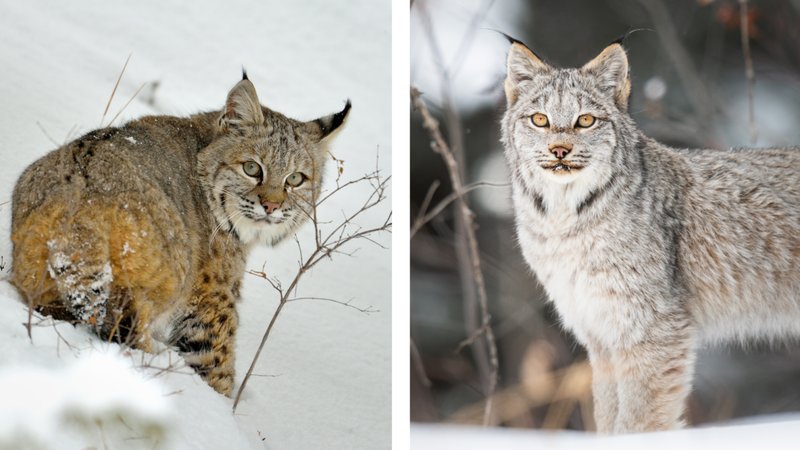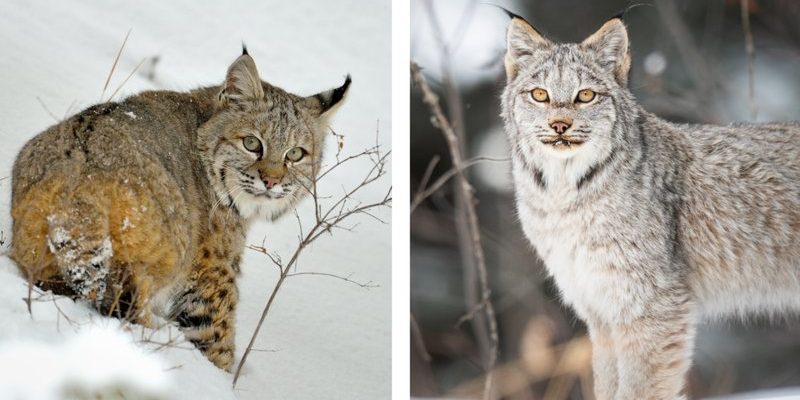
Picture this: you’re out on a nature walk or maybe even perusing through wildlife documentaries, and you spot a lynx-like creature. You might wonder, “Is that a Canada lynx or something else?” Don’t worry; you’re not alone. Many animals have comparable traits to the Canada lynx, and knowing how to distinguish them can deepen your appreciation for wildlife. So, let’s dive into the fascinating world of these animals!
1. Bobcat
The bobcat is probably the most well-known relative of the Canada lynx. They share a common ancestor and have similar physical features, but there are distinct differences. Bobcats are smaller, typically weighing between 15 to 35 pounds, whereas Canada lynx tend to be bulkier, ranging from 18 to 30 pounds.
You can spot a bobcat by its shorter tail, which is less pronounced than that of the lynx. Bobcats also have a more varied fur pattern, often displaying spots or stripes that help them blend into different environments. Their ears are less tufted, and their bodies are more slender overall. So, if you encounter a larger, fluffier cat with prominent ears in the snowy wilderness, chances are it’s a Canada lynx!
2. Eurasian Lynx
The Eurasian lynx is another relative that shares many traits with the Canada lynx. In fact, they belong to the same genus, *Lynx*. This breed is larger, with males weighing up to 67 pounds, making them one of the biggest lynx species. While they have a similar tufted ear look, their coat is more tawny and less gray than the Canada lynx.
One standout feature of the Eurasian lynx is its long legs, which help it navigate snowy terrains easily. You’ll find them in the forests of Europe and Siberia. If you can get a glimpse of one, the differences in size and fur color will jump out at you. So, if you’re wondering if that big cat in the snow is a Canada lynx or an Eurasian lynx, just look for the size difference.
3. Iberian Lynx
The Iberian lynx is currently one of the most endangered cats in the world. Native to the Iberian Peninsula in Spain and Portugal, this lynx is smaller than the Canada lynx and has a more distinct coat pattern. With a longer body and shorter legs, the Iberian lynx also has a unique blend of tawny and reddish fur with distinctive spots, making it easy to tell apart from the Canada lynx.
One interesting fact is that the Iberian lynx primarily preys on European wild rabbits. If you ever spot one, you’ll notice its shorter tufts compared to its Canadian cousin. These differences in habitat and diet are key indicators when differentiating these lynxes.
4. Caracal
Now, let’s talk about the caracal. Although it comes from a different genus (*Caracal*), this medium-sized wild cat might throw you off due to its tufted ears and general lynx-like appearance. Caracals are lean and muscular, usually weighing around 30 to 40 pounds, which makes them a bit heftier than a typical Canada lynx.
The caracal’s coat is a warm reddish-brown, which contrasts with the cooler tones of the lynx. While both cats have those distinctive ear tufts, the caracal’s ears are much longer and have a more dramatic point. Furthermore, you’ll typically find caracals in Africa and parts of Asia, while the Canada lynx calls North America home.
5. Geoffroy’s Cat
Found mainly in South America, Geoffroy’s cat is another feline that has some resemblance to the Canada lynx. Though smaller, weighing only 5 to 12 pounds, its coat is patterned with dark spots, similar to that of a young lynx. What makes it stand out is its long tail, which is not something you’d find in a Canada lynx.
While the Canada lynx prefers cold, snowy areas, Geoffroy’s cat thrives in grasslands and scrub forests. The biggest difference lies in their size and habitat preferences, so when you see a smaller cat with a spotted coat, it may just be a Geoffroy’s cat rather than a lynx.
6. Jungle Cat
The jungle cat is another fascinating feline that bears some resemblance to the lynx family. Primarily found in parts of Asia and the Middle East, the jungle cat is slightly larger than a domestic cat, weighing between 20 to 35 pounds. Their coat is a sandy or grayish color, with faint stripes, making it somewhat lynx-like in appearance.
Unlike the Canada lynx, the jungle cat has a more slender body and longer legs, perfect for navigating through dense vegetation. Its habitat consists mainly of wetlands, grasslands, and forest edges, in contrast to the lynx’s snowy terrain. So, if you spot a lean, striped cat in a tropical setting, you might be looking at a jungle cat!
7. Serval
Servals are another fascinating species that can easily be confused with lynx due to their large ears and long legs. Native to Africa, these sleek cats weigh about 20 to 40 pounds and have a golden coat adorned with black spots. Their long legs are perfect for leaping and capturing prey in tall grass.
While Canada lynx typically inhabit colder climates, servals thrive in grasslands. You can tell them apart by their long necks and smaller overall size when compared to the lynx. Servals are also known for their exceptional jumping ability, often leaping up to six feet in the air to catch birds!
8. Ocelot
Last but not least, we have the ocelot, a stunning wild cat found in South and Central America. While they are quite different in size, ocelots share some markings with the Canada lynx—but with a twist. Their coats are predominantly brownish with dark spots and stripes, which can make them visually similar from a distance.
However, ocelots are smaller, generally weighing between 20 to 35 pounds, and they have shorter legs compared to lynxes. Their habitat varies from wetlands to tropical rainforests, showcasing their adaptability. The vibrant coat and habitat preferences make it easy to spot this gorgeous feline in the wild.
There you have it! A closer look at 10 animals similar to the Canada lynx and how you can tell them apart. Whether you’re a wildlife enthusiast or just someone curious about the fascinating world of felines, knowing the differences among these animals can enhance your understanding and appreciation of nature.
Next time you’re out exploring or watching wildlife documentaries, see if you can pick out these unique features. It’s like playing a game of animal “I spy,” and it just might deepen your connection with our furry friends in the wild!

